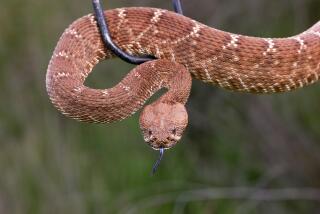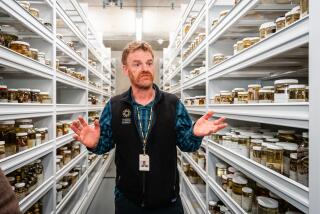Hawaii Refuses to Extend Any Alohas to Poisonous Visitor From Guam
- Share via
HONOLULU — Shortly after a huge transport plane unloaded its cargo at Hickam Air Force Base one day earlier this month, Airman John Herist happened to spot a brownish, three-foot-long snake slither into a nearby canal and disappear.
An unremarkable event by almost any measure, except that Hawaii does not have snakes and the cargo plane was from Guam, a combination of circumstances that had state and federal wildlife officials scurrying to set traps and turn loose snake-sniffing Jack Russell terriers in a frantic round-the-clock hunt for the elusive reptile, which still has not been found.
Brown tree snakes are an aggressive, venomous predator that grows to lengths of eight feet and has spread throughout Guam like a plague since arriving aboard U.S. military cargo ships from the Solomon Islands shortly after World War II. They now number 12,000 per square mile in some forested areas of the Pacific island and are eating into extinction its native bird species and most of the nonnative birds as well.
Now officials here are worried that the brown tree snake, hiding in aircraft cargo holds and wheel wells, may be invading Hawaii, threatening its wildlife habitat and tourism-dependent economy. More than a third of all the threatened and endangered birds in the United States are found in Hawaii.
A nocturnal reptile with a large head and bulging eyes, the brown tree snake prefers birds over other prey, but it has been known to eat small pets such as cats and has even been found curled around babies sleeping in their cribs. It is particularly adept at climbing trees and raiding nests. It also crawls along electrical lines and causes an average of one power outage every four days on Guam.
Hawaiian wildlife officials say that while there have been only seven confirmed cases of brown tree snakes being killed or found dead on Hawaii’s Oahu Island since 1981, the Hickam Air Base incident was the sixth snake sighting in two months. They also warn that even one pregnant female slipping through could begin a colonization far more costly than Guam’s.
“It’s an enormous threat to Hawaii, and while we always look for the ‘silver bullet’ to kill these things off, we haven’t found one yet,” said Robert Smith, Pacific islands manager for the U.S. Fish and Wildlife Service. “We’ve got to apply resources to this effort that match the cost of this threat.”
Because of its isolation, Hawaii is particularly vulnerable to invasive species like the brown tree snake, wildlife experts say. Animals here evolved with few diseases and natural predators, and therefore have few natural defenses. There are no effective predators with which the brown tree snake would have to contend while it multiplied.
But the threat is not only to Hawaii, according to U.S. Agriculture Department officials. One brown tree snake was found in a cargo in Texas, and experts predict that the reptile could easily thrive in Southern California, Florida and other warm climate states.
Thomas H. Fritts, a biologist with the U.S. Geological Survey in Washington who is widely regarded as the leading authority on brown tree snakes, said he was attempting to confirm sightings in Spain, Singapore, Okinawa and Darwin, Australia. An incipient colonization is already occurring in Saipan, he said.
The sighting at a military airfield in Darwin was ironic because Australia is where the reptile is believed to have originally evolved before island-hopping through the Pacific to Guam. “So we seem to have moved it from Guam back to Australia,” Fritts said.
Because Hawaii ostensibly has no snakes--other than two reptiles on display in the public zoo here and those illegally imported by residents who like to have them as pets--state and federal officials take their snake control efforts seriously, even though the state’s congressional delegation is often the butt of jokes when it lobbies for appropriations for alien snake control programs.
Anyone caught with a snake faces as much as a year in jail and a maximum fine of $25,000. An amnesty program allows snake owners to turn the reptiles in without prosecution.
In addition, a Coordinating Group of Alien Pest Species, comprised of 14 government agencies and private groups, last year drafted a 10-point “Silent Invasion” action plan to improve alien pest prevention and control programs. It includes a brown tree snake control plan that will be boosted by nearly $1.8 million in federal appropriations this year for combating the reptile on Guam, researching new control methods and inspecting aircraft arriving in Hawaii.
A number of measures have been taken or proposed to intercept snakes that arrive from Guam in military aircraft or other conveyances. These include a newly designed concrete barrier with a curved lip that could be erected around an airport tarmac where cargo is offloaded.
Other measures include dog detection, which is used extensively in Guam; development of new kinds of snake traps; fumigation of cargo containers, and the training of snake searchers who are marshaled when a brown tree snake is spotted loose. Experts also called for more research on chemical fertility inhibitors and the use of toxicants and viruses and parasites known to be exclusively effective against the brown tree snake.
But experts said the problem with biological controls like viruses is that they have not worked well on vertebrate species and unless an entire species population is wiped out, the survivors may develop immunities and recolonize.
High priority is also being given to public education. Even though most Hawaiians have never seen a snake, Smith said that “people here hate snakes and what might seem to be preaching to the choir really gets the congregation rattled.”
Earl Campbell, a wildlife ecologist with the USDA’s National Wildlife Research Center, said each of these control measures may be effective to a point, but he stressed that only “a gamut of techniques” used in concert will stand a chance of preventing the brown tree snake from colonizing here as it did in Guam.
“Time is of the essence. With the unique ecosystem we have in Hawaii, we can’t afford to delay. It could be disastrous for us,” Campbell said.
David Worthington, a U.S. Fish and Wildlife biologist here, said that Guam has to be the focus of much of the brown tree snake control effort because “if we don’t find a way to reduce the population there, everything else is just stopgap.”
More to Read
Sign up for Essential California
The most important California stories and recommendations in your inbox every morning.
You may occasionally receive promotional content from the Los Angeles Times.










